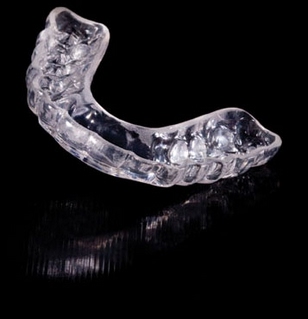Occlusal splint therapy may be defined as ‘the art and science of establishing neuromuscular harmony in the masticatory system by creating a mechanical disadvantage for parafunctional forces with removable appliances.
- Splints alter neurol, muscle and mechanical proprioception
- Primary application is diagnostic (alter proprioception and note what changed)
- Splints are protective in sleep, play and work
- Splints have the ability to be therapeutic
The natural splint that is always with us is the tongue. Day one, from birth, the tongue helps navigate and protect the airway. The infantile swallow will not allow breast milk into the lungs or we die. The combination of swallowing and breathing is a neuromuscular activity that is controlled by a subconscious process similar to your heartbeat.
Excellent airway development and neutral tongue swallows tend to create symmetrical growth patterns within the stomatognathic puzzle. A strong tongue thrust that is traditionally associated with a narrow airway will not allow the maxillary and mandibular bones to grow together producing a mild skeletal growth asymmetry that often results in an open anterior bite. One could argue that an over active tongue is an iatrogenic bite splint in growth and development. On the other hand, the tongue develops and positions itself in perfect balance for the brain to receive oxygen with every breath. Open bites, crossbites (in a any combination of unilateral, bilateral, posterior and anterior) over and under bites are all examples of a skeletal asymmetry.

If one leg grew shorter than another, one may wear a lift in the show to create a perceived sense of balance to preserve form and function of the anatomy. Standing, walking and running is a vertical posture position during the day that can be controlled by a conscious neural process. The analogy may not be perfect because sleep is a horizontal posture position at night with subconscious control. However, the idea in splint therapy is to assist form and function preventing or slowing postural destructive adaptation.
Occlusion, swallowing, breathing, and sleep posture in combination of function, dysfunction and parafunction in stress, sickness and health. Dentistry and sleep have been connected for decades and the science of sleep could easily become one of the primary factors in the advancement of life expectancy.
The oral cavity and the position of the mandible in sleep have a relationship to clenching, bruxing, TM disorders, vertigo, tinnitus, xerostomia and stress in any form. Changes may occur with age, occlusion, medications, alcohol, smoking, weight gain, and the process of life in general.
The variables are endless and 99.9% of people in the world do not even wear any style of a removable oral device in their lifetime. Most dentists experiment with a splint or two every once in a while because it’s the only option they can think of to help a complaining patient. Splints care is an afterthought in dental school and the design, style, type, material and protocol of the diagnosis and treatment seems over whelming. In general splints are too much trouble so the attitude is “why bother.” Let’s make splints simple.
The best definition for occlusal splint therapy cames from Dr. Tim J. Dylina, in the article “The Basics of Occlusal Splint Therapy.” Dr. Dylina states “Occlusal splint therapy may be defined as ‘the art and science of establishing neuromuscular harmony in the masticatory system by creating a mechanical disadvantage for parafunctional forces with removable appliances.”
See Dr. Dylina’s full article here “The Basics of Occlusal Splint Therapy“
Start with a diagnostic anterior discluding devise.
WHY: Splints are diagnostic tools and the most common use is to relax the muscles, protect the teeth, TM Joints and periodontal ligaments.
HOW: Set the mandible in a position similar to a 3 legged stool, but upside down

Any number of splints will do this.
- Anterior Deprogrammer
- NTI
- Kois Deprogrammer
- Full Splint with only anterior teeth touching
